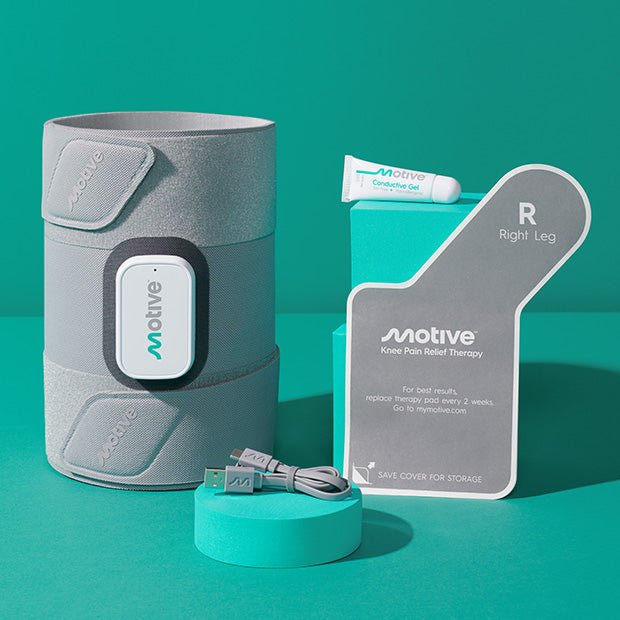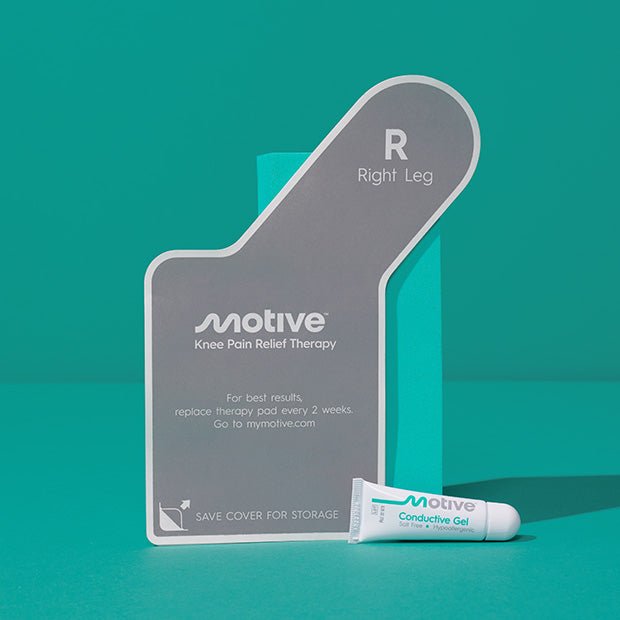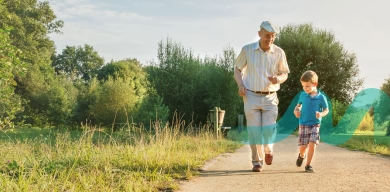
Knee pain significantly impacts daily life and mobility, restricting individuals' ability to perform basic activities such as walking, climbing stairs, and bending.
This discomfort can lead to a decrease in physical activity levels, contributing to a sedentary lifestyle and potentially exacerbating the condition, thereby affecting overall health and well-being. Conditions like osteoarthritis, rheumatoid arthritis, and sports injuries to the knee joint, including ligament sprains and meniscal tears, contribute significantly to this discomfort.
This guide targets individuals seeking at-home solutions for knee pain or limited mobility, offering insights into management strategies and introducing Motive as a solution for enhanced knee health.
Understanding Knee Pain: Causes and Symptoms
The knee joint's complex anatomy includes the femur (thighbone), tibia (shin bone), patella (kneecap), meniscus, and crucial ligaments like the anterior cruciate ligament (ACL) and collateral ligament.
Common causes of knee pain involve wear and tear of the knee cartilage, leading to osteoarthritis, inflammation from conditions like bursitis and tendinitis, and acute damage from dislocations or sports injuries.
Symptoms to monitor include swelling, stiffness, decreased range of motion, and pain, especially when moving the knee joint or going downstairs.
Home Management Strategies for Knee Pain
Initial relief can be found through the R.I.C.E. method—Rest, Ice (using an ice pack), Compression, and Elevation—and maintaining a healthy weight to reduce stress on the knee. Over-the-counter NSAIDs like ibuprofen and naproxen can offer pain relief, though it's important to be aware of potential side effects.
Supportive footwear that provides good arch support and cushioning can significantly reduce knee stress during daily activities, while knee braces or supports offer additional stability for weakened joints.
By adopting a holistic approach that combines these strategies, individuals can achieve more comprehensive relief from knee pain and enhance their quality of life.
Flexibility, Mobility, and Strengthening Exercises for Knee Support
Exercises that focus on strengthening the quadriceps, hamstrings, and lower leg muscles around the knee joint are essential. These routines not only support the patellar tendon and alleviate pressure on the knee but also help prevent further knee problems and injuries.
Incorporating calf exercises can further bolster the support system around the knee, providing a well-rounded strengthening routine. Exercises such as calf raises, where you lift your heels off the ground while standing, can enhance the stability and endurance of your lower leg muscles, further protecting the knee joint.
Bridging exercises also play a significant role in knee health by strengthening the glutes and hamstrings. Lying on your back with knees bent and feet flat on the floor, lifting your hips towards the ceiling, and then lowering them back down engages the posterior chain muscles, supporting the entire lower body.
Regular stretching exercises improve flexibility and prevent stiffness, enhancing the knee's range of motion. Low-impact exercises, particularly important for those with knee osteoarthritis or recovering from a sports injury, aid in maintaining joint mobility without exacerbating pain.
To effectively strengthen the muscles around your knee and prevent future knee problems, consider integrating Motive therapy into your routine. This innovative tool is designed to target key muscle groups supporting the knee, optimizing your strength training exercises and ensuring your knees are protected against undue stress and strain. Take the step towards healthier knees by incorporating Motive therapy into your exercise regimen, and experience the difference it makes in strengthening and protecting your knee joints.
Lifestyle Modifications to Prevent Knee Pain
Incorporating anti-inflammatory foods into your diet and making ergonomic adjustments at work and home are lifestyle changes that can reduce knee strain. Using knee braces may also offer support and alleviate pain, particularly for conditions like patellofemoral pain syndrome, runner's knee, and jumper's knee.
Adopting a diet rich in anti-inflammatory foods is a key strategy in managing knee pain. Foods high in omega-3 fatty acids, such as salmon, flaxseeds, and walnuts, alongside fruits and vegetables packed with antioxidants, like berries, spinach, and broccoli, help fight inflammation within the body, potentially reducing knee discomfort. Turmeric, with its active compound curcumin, has been particularly noted for its anti-inflammatory properties and can be an excellent addition to your meals.
For active individuals or those with specific knee conditions, wearing a knee brace provides additional support for the joint, distributing stress more evenly across the knee and helping to alleviate pain from conditions like patellofemoral pain syndrome. These simple yet effective lifestyle changes, when implemented consistently, can significantly impact overall knee health, reducing pain, enhancing mobility, and preventing overuse.
Regain Mobility with Motive
By adopting the strategies discussed, from simple home remedies to targeted exercises and Motive therapy, individuals can achieve significant relief from knee pain. This proactive approach towards knee health can restore mobility, reduce the need for interventions like knee replacement, and improve overall quality of life.
Motive offers a personalized approach to managing knee pain, with technology designed to strengthen the knee and enhance mobility. It's ideal for individuals facing common knee problems, providing a structured program that complements physical therapy and other treatment options.
Contact us to learn more about a future with relief from knee pain.




